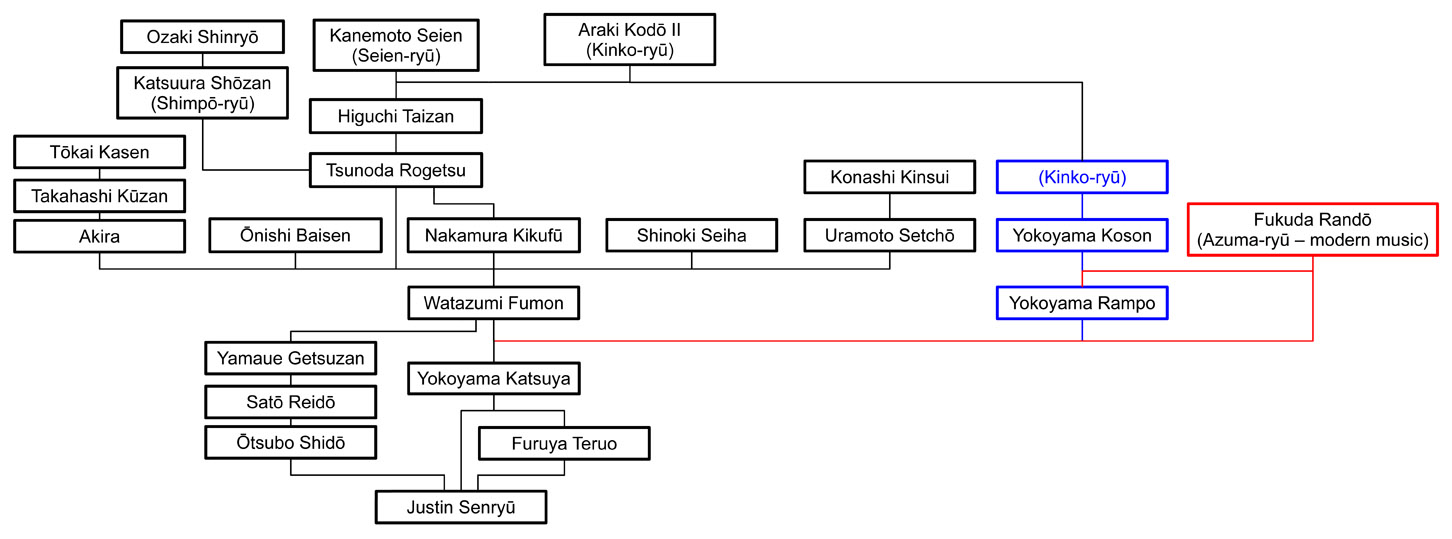Watazumi (as his name is usually written, though in fact correctly spelled Wadatsumi), was born in Kyūshū, and lived in the area of Itchōken temple, which had been destroyed along with all of the other komusō temples. He learned to play shakuhachi from a number of local komusō, and also studied Taizan-ryū which had become very popular in Kyūshū at that time. He was greatly admired from a young age, and with the support of the local players and community he revived the tradition of the Itchōken temple tradition. During this time he was known as Itchō Fumon, head of Itchōken. It was in this period that Kyūshū shakuhachi master Yamaue Getsuzan studied from him. For more about Justin’s studies of Yamaue’s lineage, see here.
He eventually left Kyūshū and traveled Japan, learning from a various teachers, and settled in Tōkyo where he opened his school and taught a number of students. The most famous of these was Yokoyama Katsuya, who became key in spreading this lineage both throughout Japan and internationally. As well as studying honkyoku from Watazumi, Yokoyama learned Kinko-ryū and modern music from his father and Fukuda Randō, and was key in introducing the shakuhachi to the Western classical world through his performance of November Steps abroad, a piece composed for shakuhachi, biwa and orchestra by Takemitsu Tōru.
Yokoyama has also worked hard to promote the interest and accessibility of honkyoku to shakuhachi schools which do not have honkyoku in their repertoire (such as Tozan-ryū who play no komuso music at all, although they use the name “honkyoku” for Nakao Tozan’s compositions). As well teaching through his school, Chikushinkai, he held the first ever International Shakuhachi Festival, and has regularly taught seminars open to everyone (which is unusual in Japan) through the Kokusai Shakuhachi Kenshukan. These activities continue to be a major influence in the shakuhachi world both through him and his students here in Japan and abroad.
Justin speaks in his own words about his studies:
“It has been a great honor to study with Yokoyama-sensei’s principle student Furuya Teruo. Furuya-sensei has outstanding musicianship and also an outstanding ability in being able to guide his students and draw out both their musicianship and also individuality. Anyone who has met Furuya-sensei will also know how kind a man he is, and this has also been an essential teaching for which I will always be grateful.
On the advice of Furuya-sensei I also studied directly with Yokoyama-sensei. Yokoyama-sensei is a real wealth of insight as lessons are wonderful both for the musical depth he imparts as well as the wonderful stories that he shares with us.”
Furuya and Yokoyama awarded Justin his Shihan (Master teaching license), and to certify his mastery of both playing and making shakuhachi, Yokoyama awarded him the name “Senryū” (泉龍), which means “Dragon of the Spring”.
As well as studying with Chikushinkai, Justin also learned some of Watazumi’s honkyoku not contained in the Chikushinkai repertoire, from Ōtsubo Shidō in Nagasaki. Ōtsubo sensei is the principal holder of Yamaue Getsuzan‘s lineage, and transmitted to Justin rare pieces such as Saji and Itchōken Kokū. These are particularly interesting not only due to their rarity, but also since Watazumi was so young when he transmitted these pieces to Yamaue, and so they embody a slightly different style than that which he played later in his life.
The lineage of the Fuke-shu honkyoku is complex and can be hard to trace. The komusō often wandered around Japan and would learn from a variety of teachers or exchange honkyoku with their fellows. Below is a small part of the complex web of the lineage of transmission of the honkyoku received and taught by Watazumi. In red and blue are the other elements which contribute to the repertoire of the Chikushinkai school:
Listen to Tamuke:
Justin’s performance of Tamuke, one of the most respected pieces in this repertoire, at the European Shakuhachi Festival in Prague, 2010.
Instrument: Senryu Jinashi 3.4
[weaver_youtube http://youtu.be/xUbUiKQ4WJM sd=0 percent=80 ratio=.5625 center=1 rel=0 https=0 privacy=0]


